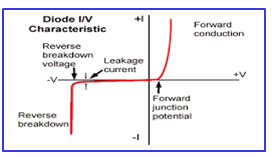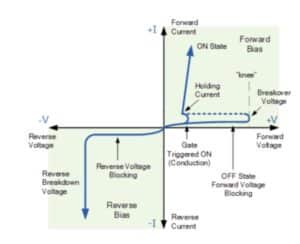Difference Between Ohmic and non-Ohmic Conductors:
Ohmic Conductors:
The conductors that obey the ohm’s law are called ohmic conductors. In an ohmic conductor, the current and the voltage have a linear relationship. The current increases or decreases as the voltage is increased or decreased. The non-ohmic conductor has a non-linear current-voltage relationship.
The resistance, inductance, and capacitor follow Ohm’s law—the current increases with an increase in the voltage.
Ohm’s Law:
R= V/I
I=V/R
Where,
V= Applied Voltage
I = Current in the circuit
R = Circuit Resistance
If the slope of the V-I graph is constant, the current and voltage have a linear relationship. The slope of the V-I graph can be constant only if the resistance of the circuit remains unchanged.
Non-Ohmic Conductors:
The nonohmic conductor does not follow Ohm’s Law, and the current drawn by the nonohmic conductor does not proportionately vary with the varying applied voltage. The resistance of a non-ohmic conductor does not remain constant when voltage is applied across it. The changing resistance results in a change in the current for a particular voltage, and the V-I graph is no longer linear.

If we take the slope of the V-I curve of the above graphs, the resistor has a constant slope because of the constant resistance. The filament has variable resistance because the slope of the V-I graph is not constant.
All the semiconductor devices are non-linear devices because the current drawn by the devices is not proportional to the applied voltage. The semiconductor devices have a barrier potential, and when the applied voltage is increased above the barrier potential, the device starts conducting. If the voltage is increased above the barrier potential, the voltage across the device remains constant, and the current starts increasing. This happens because the concentration of the holes and electrons increases as the current through the device is increased. The resistance of the PN junction is not constant and does vary with the flow of electric current through the junction. The voltage and current have nonlinearity in the semiconductor junction diode.
Almost all the semiconductor devices which have nonlinear V-I relationships are depicted below.

The V-I graph of the semiconductor diode has an exponential relationship.

If we see the V-I curves of a semiconductor device, the current rises abruptly when the voltage reaches a particular value. The diode current equation is given below.

Where,
Io= Saturation Current
q= Charge of an electron- 1.6 *10–19 Coulomb
K=Boltzmann Constant- 1.38 * 10– 23 JK–1
T= Temperature(K)
The diode current increases exponentially when the voltage is increased above a particular value.
Similarly, the V-I characteristics of silicon control rectifier(SCR) are also non-linear.

The non-linear characteristics of the devices produce harmonics in the system. The nonlinearity in the current with applied voltage causes harmonic distortion and other problems in the electrical network. Insulated Gate Bipolar Transistors (IGBTs) are widely used in variable frequency drives and uninterrupted power supply(UPS). The IGBT has non-linear V-I characteristics.

The collector current does not vary proportionately with an increase in the collector-to-emitter voltage.